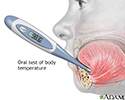Roseola
Exanthem subitum; Sixth diseaseRoseola is a viral infection that commonly affects infants and young children. It involves a pinkish-red skin rash and high fever.
Causes
Roseola is common in children ages 3 months to 4 years, and most common in those ages 6 months to 1 year.
It is caused by a virus called human herpesvirus 6 (HHV-6), although similar syndromes are possible with other viruses.
Symptoms
The time between becoming infected and the beginning of symptoms (incubation period) is 5 to 15 days.
The first symptoms include:
- Eye redness
- Irritability
- Runny nose
- Sore throat
- High fever, that comes on quickly and may be as high as 105°F (40.5°C) and can last 3 to 7 days
About 2 to 4 days after becoming sick, the child's fever lowers and a rash appears. This rash most often:
- Starts on the middle of the body and spreads to the arms, legs, neck, and face
- Is pink or rose-colored
- Has small sores that are slightly raised
The rash lasts from a few hours to 2 to 3 days. It usually does not itch.
Exams and Tests
Your health care provider will perform a physical exam and ask questions about the child's medical history. The child may have swollen lymph nodes in the neck or back of the scalp.
Treatment
There is no specific treatment for roseola. The disease most often gets better on its own without complications.
Acetaminophen (Tylenol) and cool sponge baths can help reduce the fever. Some children may have seizures when they get a high fever. If this occurs, call your provider or go to the closest emergency room.
Possible Complications
Complications may include:
-
Aseptic meningitis (rare)
Meningitis
Meningitis is an infection of the membranes covering the brain and spinal cord. This covering is called the meninges.
 ImageRead Article Now Book Mark Article
ImageRead Article Now Book Mark Article -
Encephalitis (rare)
Encephalitis
Encephalitis is irritation and swelling (inflammation) of the brain, most often due to infections.
 ImageRead Article Now Book Mark Article
ImageRead Article Now Book Mark Article -
Febrile seizure
Febrile seizure
A febrile seizure is a convulsion in a child triggered by a fever.
 ImageRead Article Now Book Mark Article
ImageRead Article Now Book Mark Article
When to Contact a Medical Professional
Contact your provider if your child:
- Has a fever that does not go down with the use of acetaminophen (Tylenol) or ibuprofen (Advil) and a cool bath
- Continues to appear very sick
- Is irritable or seems extremely tired
Go to the emergency room or call the local emergency number (such as 911) if your child has convulsions.
Prevention
Careful handwashing can help prevent the spread of the viruses that cause roseola.
References
Cherry J. Roseola infantum (exanthem subitum). In: Cherry JD, Harrison GJ, Kaplan SL, Steinbach WJ, Hotez PJ, eds. Feigin and Cherry's Textbook of Pediatric Infectious Diseases. 8th ed. Philadelphia, PA: Elsevier; 2019:chap 59.
Tesini BL, Caserta MT. Roseola (human herpesviruses 6 and 7). In: Kliegman RM, St. Geme JW, Blum NJ, Shah SS, Tasker RC, Wilson KM, eds. Nelson Textbook of Pediatrics. 21st ed. Philadelphia, PA: Elsevier; 2020:chap 283.
-
Roseola - illustration
Roseola is an acute disease of infants and young children that is characterized by high fever followed by a rash that appears on trunk, limbs, neck and face.
Roseola
illustration
-
Temperature measurement - illustration
A thermometer is a useful aid used to measure body temperature.
Temperature measurement
illustration
-
Roseola - illustration
Roseola is an acute disease of infants and young children that is characterized by high fever followed by a rash that appears on trunk, limbs, neck and face.
Roseola
illustration
-
Temperature measurement - illustration
A thermometer is a useful aid used to measure body temperature.
Temperature measurement
illustration
Review Date: 8/5/2023
Reviewed By: Neil K. Kaneshiro, MD, MHA, Clinical Professor of Pediatrics, University of Washington School of Medicine, Seattle, WA. Also reviewed by David C. Dugdale, MD, Medical Director, Brenda Conaway, Editorial Director, and the A.D.A.M. Editorial team.



